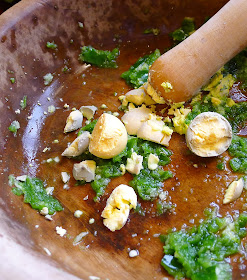That holiday is over, but there are more to come. Ideally, I would have posted this recipe way before Thanksgiving, but I didn’t really plan that far in advance. So, after-the-fact—but in plenty of time for the next batch of holidays—here is an elegant way to serve a turkey breast.
The boneless breast is butterflied and rolled around a stuffing with figs and chopped nuts. If you’re using a larger turkey breast, simply increase the quantities of stuffing ingredients. The stuffing mixture can also be used for chicken breasts or butterflied pork loin.
I served the turkey roulade for a small Thanksgiving dinner, accompanied by roasted brussels sprouts, sweet potatoes and a mushroom-sage “dressing,” made with quinoa instead of the usual bread. The special treat was fresh cranberry sauce, the American berries brought by a visitor from the U.S.
 |
| Butterflied turkey breast rolled around a fig stuffing roasts in about one hour. |
 |
| Make pan gravy with a little Sherry added to the drippings. |
Turkey Breast Roulade with Fig Stuffing
Rollo de Pavo Relleno de Higos
The recommended internal temperature for cooked turkey is 165ºF, but I find that turkey breast that has been butterflied is done at 150ºF. Longer roasting will make dry meat.
The turkey doesn’t quite brown in this roasting time. I sprinkled the top with a little pimentón to add color. Another idea is to add a glaze with honey or sugar that will brown nicely.
The fig compôte used in the stuffing is made from dried figs that have been stewed in water (no sugar) until soft, then pureed.
I used rendered ibérico panceta fat (see last week’s blog for more about panceta) to sauté the shallots and baste the turkey, adding a very special flavor, but olive oil can be used as well.
 |
| Fig compôte, goat cheese, rosemary, ham, nuts. |
Serves 4.
1 ¾ pounds boneless turkey breast
Salt
Freshly ground black pepper
3 tablespoons rendered pork fat or olive oil
1 shallot, finely chopped
½ teaspoon chopped fresh rosemary
½ cup fresh bread crumbs
1 tablespoon dry Sherry
2 ounces chopped goat cheese log (1/2 cup)
2 tablespoons chopped ibérico ham or bacon
3 tablespoons fig compôte or puree
1 tablespoon chopped walnuts
1 tablespoon chopped parsley
Sprigs of fresh rosemary
¼ cup white wine or Sherry
Pimentón (paprika)
 |
| Add cheese to hot pan. |
Place the turkey on a cutting board. Slice horizontally through the thickest side without cutting all the way through. Open the piece of meat up like a book. If one section is much thicker than the other, again slice horizontally and open up the flap to make a slab more or less rectangular. Sprinkle with salt and pepper and allow it to come to room temperature.
In a small skillet heat 1 tablespoon of the fat or oil. Sauté the shallot on medium heat until softened, 4 minutes. Add the rosemary and the bread crumbs. Fry briefly, stirring to mix the crumbs with the shallots. Add the Sherry and cook another minute. Remove the pan from the heat and stir the chopped cheese into the hot pan. Add the ham or bacon, the fig compôte, walnuts and parsley. Season with salt and pepper.
 |
| Spread filling and roll up the turkey breast. |
Spread the crumb-fig stuffing on the opened slab of turkey breast. Roll the turkey up, enclosing the filling. Secure the roll with skewers or kitchen twine. Place it in an oven pan. Spread remaining fat or oil over the surface of the turkey. Place sprigs of rosemary on top.
Preheat oven to 400ºF.
 |
| Spread rolled turkey with fat or oil before roasting. |
Place the turkey in the oven and roast 15 minutes. Reduce oven temperature to 350ºF and roast 15 minutes more. Pour over the wine, baste the turkey with pan juices and sprinkle the top with pimentón. Return the turkey to the oven until done (internal temperature of at least 150ºF tested on an instant-read thermometer), 20- 30 minutes more.
Remove from oven and allow the turkey to rest at least 10 minutes. Remove skewers or twine and slice crosswise. (Make gravy, if desired, with pan drippings, stock, a slosh of Sherry and cornstarch to thicken.)
More turkey recipes, some suitable for leftovers:
And, stuffed pork loin: Pork Loin with Fig Stuffing.




























